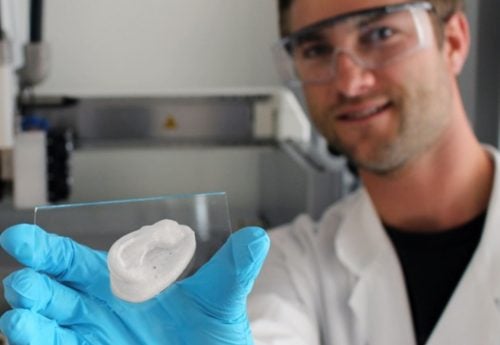
Empa researcher Michael Hausmann holds up a 3D printed ear. He uses nanocellulose as the basis for new implants. (Image: empa.ch)
Scientists at Empa have used cellulose to 3D print an ear. Cellulose is the main chemical that forms the principal structure of plants. Most of the cell wall of a plant cell consists of cellulose. The cellulose that the scientists used to 3D print the ear comes from wood. The researchers are currently equipping cellulose with additional functionalities to 3D print implants for cartilage diseases.
Empa (Eidgenössische Materialprüfungs- und Forschungsanstalt) is the German acronym for the Swiss Federal Laboratories for Materials Science and Technology.
Researchers from Empa, ETH Zürich, and Anton Paar Germany GmbH wrote about their work in the journal ACS Nano (citation below). The authors were MK. Hausmann, PA. Rühs, G. Siqueira, J. Läuger, R. Libanori, T. Zimmermann, and AR. Studart.
3D printer makes an ear
It all begins with something that looks like a human ear. Michael Hausmann, an Empa researcher, removes an object with a human ear shape from the 3D printer, and then explains:
“In viscous state cellulose nanocrystals can easily be shaped together with other biopolymers into complex 3-dimensional structures using a 3D printer, such as the Bioplotter.”
As soon as they are cross-linked, the structures remain stable in spite of their soft mechanical properties.
Hausmann is currently researching the characteristics of the nanocellulose composite hydrogels. He wants to optimize their stability further. He also aims to optimize the printing process.
Hausmann has already used X-ray analysis to determine how cellulose is organized and distributed within the structures that the 3D printer creates.
With the bioplotter, it is possible to print the viscous nanocellulose hydrogel into complex shapes. (Image: Empa)
Ear currently made of cellulose nanocrystals and a biopolymer
At this point, the 3D printed ear is completely and solely made of a biopolymer and cellulose nanocrystals. However, the goal is to incorporate both therapeutic and human cells into the base structure in order to create biomedical implants.
A new study is underway to find out how to integrate chondrocytes into the scaffold to yield cartilage tissue. Chondrocytes are cartilage cells.
In a press release, Empa explains:
“As soon as the colonization of the hydrogel with cells is established, nanocellulose based composites in the shape of an ear could serve as an implant for children with an inherited auricular malformation as for instance, in microtia, where the external ears are only incompletely developed.”
“A reconstruction of the auricle can esthetically and medically correct the malformation; otherwise the hearing ability can be severely impaired. In the further course of the project, cellulose nanocrystals containing hydrogels will also be used for the replacement of articular cartilage (e.g. knee) in cases of joint wear due to, for example, chronic arthritis.”
Biodegradable polymer will gradually degrade
After implanting the artificial tissue in the human body, the polymer, which is biodegradable, is expected to degrade eventually.
The cellulose is biocompatible in the body but not degradable. However, nanocellulose is perfect for implant scaffolds not just because of its biocompatibility.
Hausmann explains:
“It is also the mechanical performance of cellulose nanocrystals that make them such promising candidates because the tiny but highly stable fibers can extremely well reinforce the produced implant.”
Furthermore, with nanocellulose, the incorporation of several functions are possible by chemical modifications into the viscous hydrogel. Therefore, the mechanical properties, structure, and interactions of the nanocellulose with its environment can be tailored for specific end products.
An Empa researcher explained:
“For instance, we can incorporate active substances that promote the growth of chondrocytes or that sooth joint inflammation into the hydrogel.”
Of all the natural polymers, cellulose is also the most abundant on Earth.
3D printing
3D printing creates objects by adding layer upon layer until the finished product is completed. It is a type of additive manufacturing.
It contrasts with subtractive manufacturing, which starts with, for example, a block of metal, and gradually removes bits.
Citation
“Dynamics of Cellulose Nanocrystal Alignment during 3D Printing; MK. Hausmann,” PA. Rühs, G. Siqueira, J. Läuger, R. Libanori, T. Zimmermann, and AR. Studart; ACS Nano 2018, 12, 7, 6926-6937. DOI: 10.1021/acsnano.8b02366.
